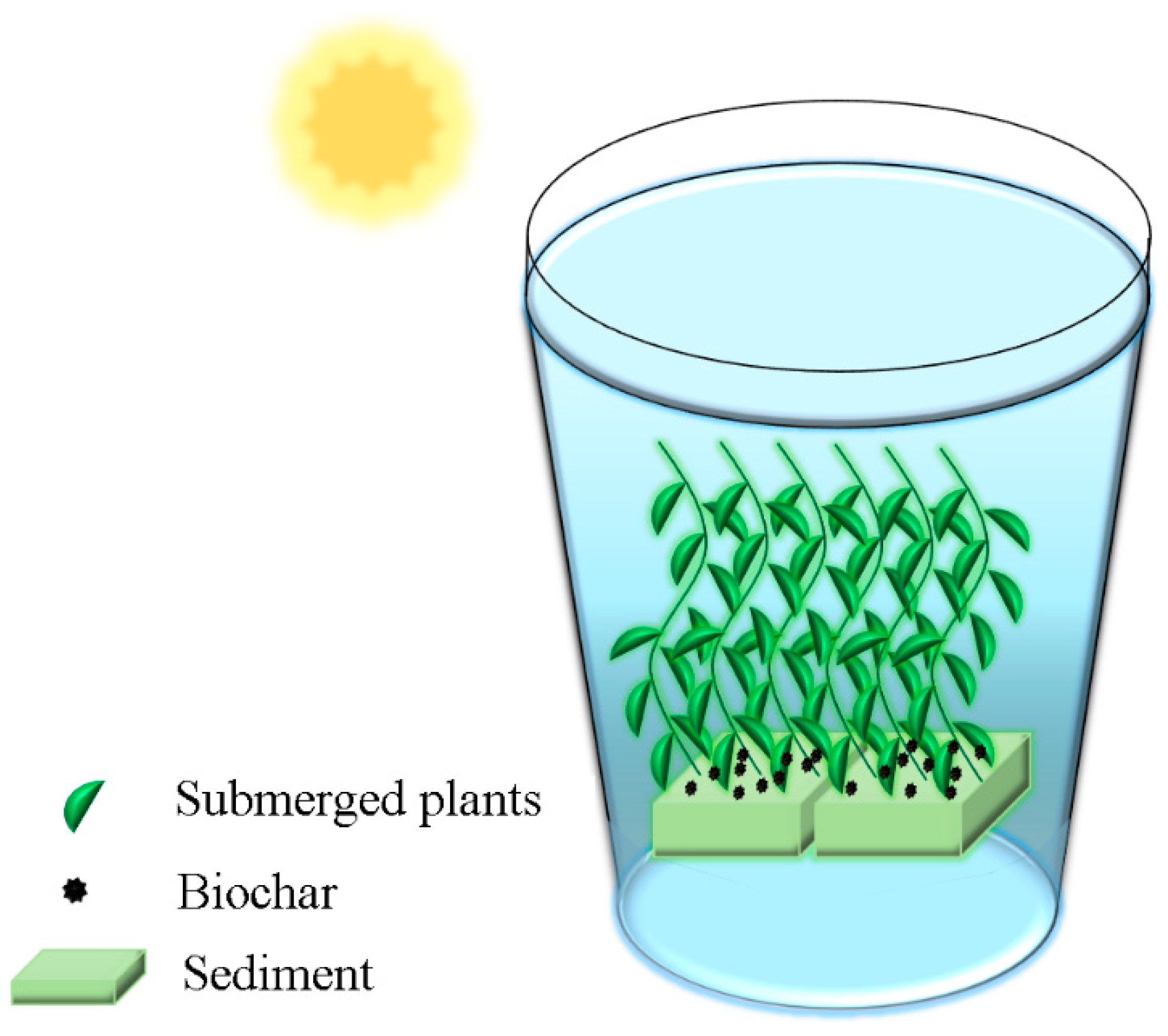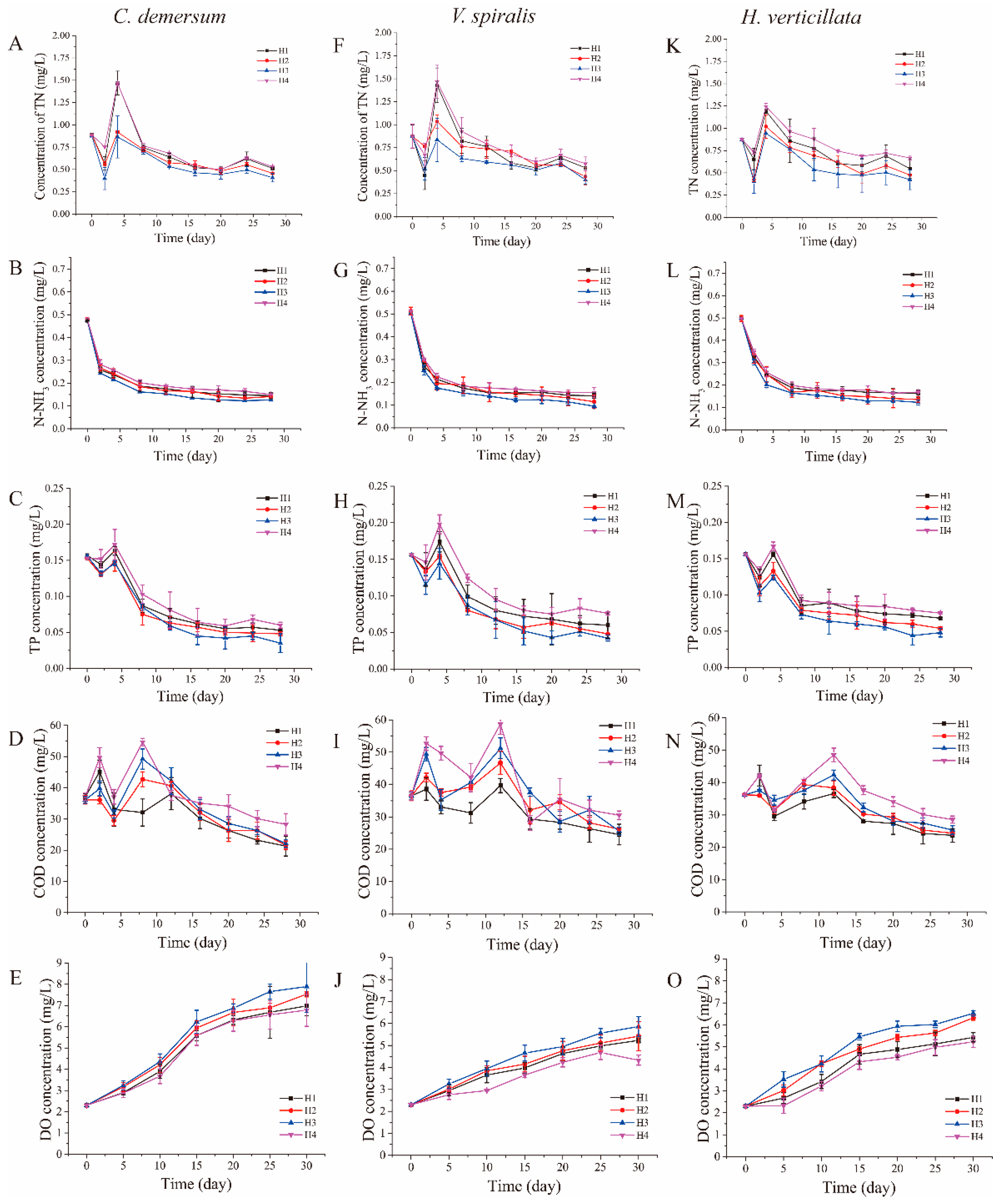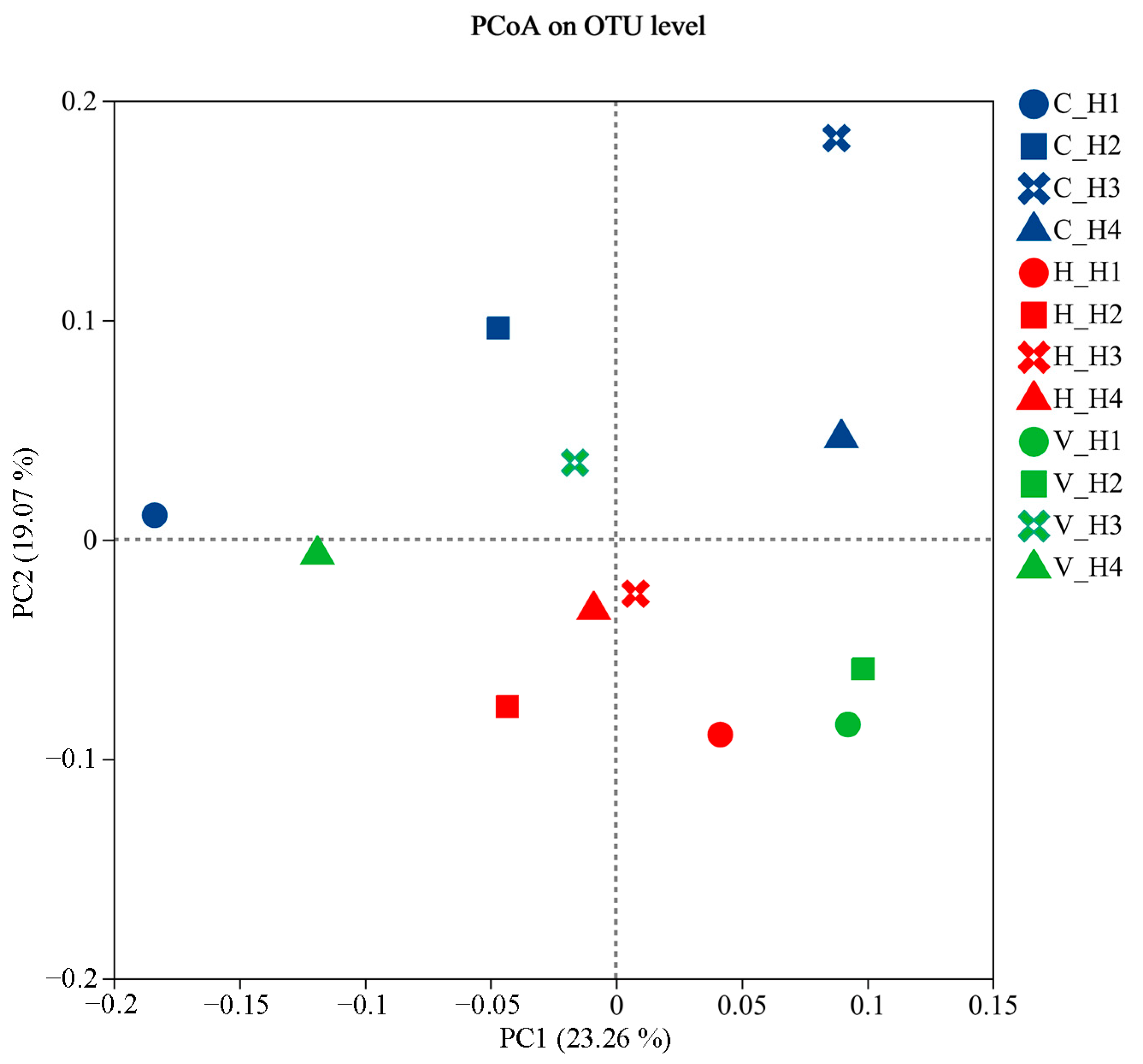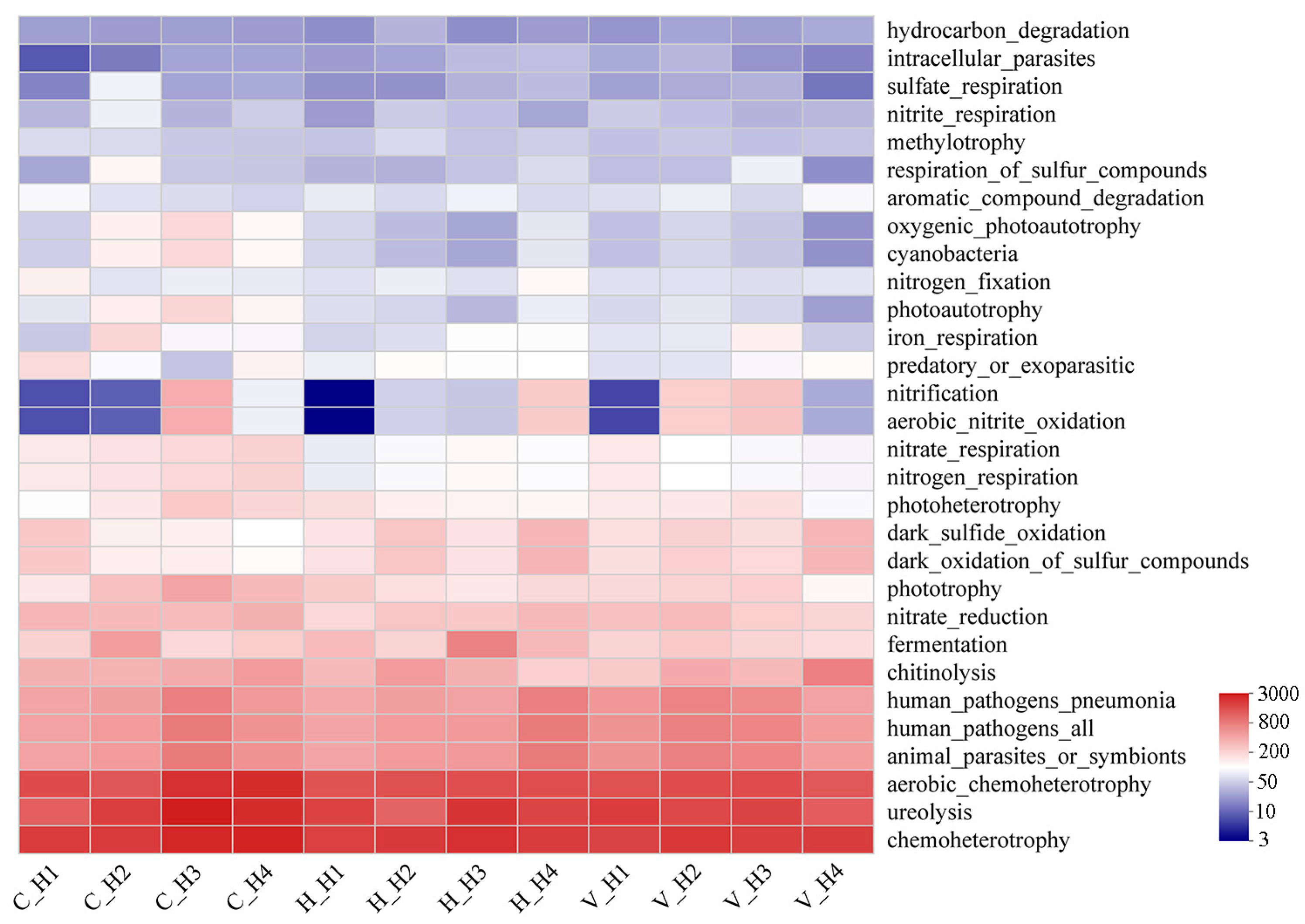Dredging Area Ecosystem Restoration Based on Biochar-Improved Sediment and Submerged Plant System
Abstract
:1. Introduction
2. Materials and Methods
2.1. Production and Characterization of Biochar
2.2. Modification of Sediment by Biochar
2.3. Construction of Micro-Ecosystem
2.4. Analysis Method of Water Quality and Biomass
- C1—Chlorophyll-a content, mg/L
- C2—Chlorophyll-b content, mg/L
- C3—Carotenoid content, mg/L
- C—Chlorophyll content, mg/g
- V—Extraction volume, mL
- N—Dilution ratio
- M—Sample quality, g
- D is the relative growth rate of submerged macrophytes, mg/(g·d)
- Wf is the wet weight of submerged plants at the end of the experiment, g
- Wi is the wet weight of submerged plants at the beginning of the experiment, g
- t is the time, day
2.5. High Throughput Sequencing Analysis
2.6. Statistical Analysis
3. Results and Discussion
3.1. Characteristics of Biochar
3.2. Effects of Biochar on Submerged Plants
3.3. Effect of Biochar on Decontamination Efficiency of Submerged Plant System
3.4. Analysis of Microbial Community in Constructed Submerged Plant Systems
4. Conclusions
Author Contributions
Funding
Data Availability Statement
Acknowledgments
Conflicts of Interest
References
- Yan, J.; Li, F. Effects of sediment dredging on freshwater system: A comprehensive review. Environ. Sci. Pollut. Res. 2023, 30, 119612–119626. [Google Scholar] [CrossRef] [PubMed]
- Dai, Y.; Jia, C.; Liang, W.; Hu, S.; Wu, Z. Effects of the submerged macrophyte Ceratophyllum demersum L. on restoration of a eutrophic waterbody and its optimal coverage. Ecol. Eng. 2012, 40, 113–116. [Google Scholar] [CrossRef]
- Shehzadi, M.; Afzal, M.; Khan, M.U.; Islam, E.; Mdbin, A.; Anwar, S.; Khan, Q.M. Enhanced degradation of textile effluent in constructed wetland system using Typha domingensis and textile effluent-degrading endophytic bacteria. Water Res. 2014, 58C, 152–159. [Google Scholar] [CrossRef]
- Wang, S.; Fu, B.; Gao, G.; Liu, Y.; Zhou, J. Responses of soil moisture in different land cover types to rainfall events in a re-vegetation catchment area of the Loess Plateau, China. Catena 2013, 101, 122–128. [Google Scholar] [CrossRef]
- Papanikolaou, N.; Britton, A.J.; Helliwell, R.C.; Johnson, D. Nitrogen deposition, vegetation burning and climate warming act independently on microbial community structure and enzyme activity associated with decomposing litter in low-alpine heath. Global Change Biol. 2010, 16, 3120–3132. [Google Scholar] [CrossRef]
- Layglon, N.; Misson, B.; Durieu, G.; Coclet, C.; D’Onofrio, S.; Dang, D.H.; François, D.; Mullot, J.-U.; Mounier, S.; Lenoble, V.; et al. Long-term monitoring emphasizes impacts of the dredging on dissolved Cu and Pb contamination along with ultraplankton distribution and structure in Toulon Bay (NW Mediterranean Sea, France). Mar. Pollut. Bull. 2020, 156, 111196. [Google Scholar] [CrossRef] [PubMed]
- Shackley, S.; Carter, S.; Knowles, T.; Middelink, E.; Haefele, S.; Haszeldine, S. Sustainable gasification–biochar systems? A case-study of rice-husk gasification in Cambodia, Part II: Field trial results, carbon abatement, economic assessment and conclusions. Energy Policy 2012, 41, 618–623. [Google Scholar] [CrossRef]
- Wu, W.; Yang, M.; Feng, Q.; McGrouther, K.; Wang, H.; Lu, H.; Chen, Y. Chemical characterization of rice straw-derived biochar for soil amendment. Biomass Bioenergy 2012, 47, 268–276. [Google Scholar] [CrossRef]
- Dai, Y.; Wang, W.; Lu, L.; Yan, L.; Yu, D. Utilization of biochar for the removal of nitrogen and phosphorus. J. Clean. Prod. 2020, 257, 120573. [Google Scholar] [CrossRef]
- Sarfraz, R.; Yang, W.; Wang, S.; Zhou, B.; Xing, S. Short term effects of biochar with different particle sizes on phosphorous availability and microbial communities. Chemosphere 2020, 256, 126862. [Google Scholar] [CrossRef]
- Chi, J.; Liu, H. Effects of biochars derived from different pyrolysis temperatures on growth of Vallisneria spiralis and dissipation of polycyclic aromatic hydrocarbons in sediments. Ecol. Eng. 2016, 93, 199–206. [Google Scholar] [CrossRef]
- Cairns, S.; Robertson, I.; Sigmund, G.; Street-Perrott, A. The removal of lead, copper, zinc and cadmium from aqueous solution by biochar and amended biochars. Environ. Sci. Pollut. Res. 2020, 27, 21702–21715. [Google Scholar] [CrossRef] [PubMed]
- Guo, W.; Lu, S.; Shi, J.; Zhao, X. Effect of corn straw biochar application to sediments on the adsorption of 17alpha-ethinyl estradiol and perfluorooctane sulfonate at sediment-water interface. Ecotoxicol. Environ. Saf. 2019, 174, 363–369. [Google Scholar] [CrossRef] [PubMed]
- Li, Y.; Xiong, X.; Zhang, C.; Liu, A. Sustainable restoration of anoxic freshwater using environmentally-compatible oxygen-carrying biochar: Performance and mechanisms. Water Res. 2022, 214, 118204. [Google Scholar] [CrossRef] [PubMed]
- Xiong, X.; Li, Y.; Zhang, C.; Zhou, X. Water quality improvement and consequent N2O emission reduction in hypoxic freshwater utilizing green oxygen-carrying biochar. Sci. Total Environ. 2023, 872, 162251. [Google Scholar] [CrossRef] [PubMed]
- Deng, C.; Huang, L.; Liang, Y.; Xiang, H.; Jiang, J.; Wang, Q.; Hou, J.; Chen, Y. Response of microbes to biochar strengthen nitrogen removal in subsurface flow constructed wetlands: Microbial community structure and metabolite characteristics. Sci. Total Environ. 2019, 694, 133687. [Google Scholar] [CrossRef] [PubMed]
- Lehmann, J.; Rillig, M.C.; Thies, J.; Masiello, C.A.; Hockaday, W.C.; Crowley, D. Biochar effects on soil biota—A review. Soil Biol. Biochem. 2011, 43, 1812–1836. [Google Scholar] [CrossRef]
- Wang, X.; Zhao, Y.; Yao, G.; Lin, Z.; Xu, L.; Jiang, Y.; Jin, Z.; Shan, S.; Ping, L. Responses of aquatic vegetables to biochar amended soil and water environments: A critical review. RSC Adv. 2023, 13, 4407–4421. [Google Scholar] [CrossRef] [PubMed]
- Jieyun, L.; Husen, Q.; Hong, T.; Jianlin, S.; Jinshui, W. Effects of Biochar Amendment on Soil Microbial Biomass Carbon, Nitrogen and Dissolved Organic Carbon, Nitrogen in Paddy Soils. Environ. Sci. 2019, 40, 3799–3807. [Google Scholar] [CrossRef]
- Awad, Y.M.; Blagodatskaya, E.; Ok, Y.S.; Kuzyakov, Y. Effects of polyacrylamide, biopolymer, and biochar on decomposition of soil organic matter and plant residues as determined by 14C and enzyme activities. Eur. J. Soil Biol. 2012, 48, 1–10. [Google Scholar] [CrossRef]
- Li, C.Y.; Chen, L.; Wang, T.F.; Li, L.Q.; Liao, G.Y.; Zhang, W.J.; Wang, D.S. Nitrogen and phosphorus diffusive fluxes across the sediment-water interface before and after dredging typical areas of Baiyangdian Lake. Acta Sci. Circumstantiae 2021, 41, 1401–1409. [Google Scholar]
- Song, Z.; Shi, X.; Liu, Z.; Sun, D.; Cao, N.; Mo, Y.; Zhao, S.; Zhao, C.; Yang, Y. Synthesis and characterization of reed-based biochar and its adsorption properties for Cu2+ and bisphenol A (BPA). Environ. Chem. 2020, 39, 2196–2205. [Google Scholar]
- Jin, S.; Zhou, J.; Bao, W.; Li, D.; Li, Y. Comparison of Nitrogen and Phosphorus Uptake and Water Purification Ability of Five Submerged Macrophytes. Environ. Sci. 2017, 38, 156–161. [Google Scholar]
- Zhang, Z.; Liu, H.; Sun, C.; Ma, Q.; Bu, H.; Chong, K.; Xu, Y. A C2H2 zinc-finger protein OsZFP213 interacts with OsMAPK3 to enhance salt tolerance in rice. J. Plant Physiol. 2018, 229, 100–110. [Google Scholar] [CrossRef] [PubMed]
- Liu, Y.; Wei, L.; Yu, H.; Cao, X.; Peng, J.; Liu, H.; Qu, J. Negative impacts of nanoplastics on the purification function of submerged plants in constructed wetlands: Responses of oxidative stress and metabolic processes. Water Res. 2022, 227, 119339. [Google Scholar] [CrossRef]
- Pérez-Jaramillo, J.E.; de Hollander, M.; Ramírez, C.A.; Mendes, R.; Raaijmakers, J.M.; Carrión, V.J. Deciphering rhizosphere microbiome assembly of wild and modern common bean (Phaseolus vulgaris) in native and agricultural soils from Colombia. Microbiome 2019, 7, 114. [Google Scholar] [CrossRef]
- Bing, W.; Shanshan, Z.; Zhijia, Q.; Qiang, G.; Yujie, L.; Shuxia, L. Effect of biochar on adsorption-desorption characteristics of nitrate nitrogen in black soil. J. Agro-Environ. Sci. 2016, 35, 115–121. [Google Scholar] [CrossRef]
- Deenik, J.L.; McClellan, T.; Uehara, G.; Antal, M.J.; Campbell, S. Charcoal volatile matter content influences plant growth and soil nitrogen transformations. Soil Sci. Soc. Am. J. 2010, 74, 1259–1270. [Google Scholar] [CrossRef]
- Solaiman, Z.M.; Murphy, D.V.; Abbott, L.K. Biochars influence seed germination and early growth of seedlings. Plant Soil 2011, 353, 273–287. [Google Scholar] [CrossRef]
- Liao, S.; Pan, B.; Li, H.; Zhang, D.; Xing, B. Detecting free radicals in biochars and determining their ability to inhibit the germination and growth of corn, wheat and rice seedlings. Environ. Sci. Technol. 2014, 48, 8581–8587. [Google Scholar] [CrossRef]
- Li, Y.; Huang, M.; Shen, F.; Guo, H.; Qing, W. Phytotoxic Effects of Biochar on Seed Germination and Early Growth of Wheat. Asian J. Ecotoxicol. 2017, 12, 234–242. [Google Scholar]
- Xu, W.; Wang, G.; Deng, F.; Zou, X.; Ruan, H.; Chen, H.Y.H.; Aitkenhead, M. Responses of soil microbial biomass, diversity and metabolic activity to biochar applications in managed poplar plantations on reclaimed coastal saline soil. Soil Use Manag. 2018, 34, 597–605. [Google Scholar] [CrossRef]
- Wei, H.; Cheng, S.; He, F.; Liang, W.; Wu, Z. Growth responses and adaptations of the emergent macrophyte Acorus calamus Linn. to different water-level fluctuations. J. Freshwater Ecol. 2014, 29, 101–116. [Google Scholar] [CrossRef]
- Li, W.; Zhou, J.; Ding, H.; Fu, H.; Liu, J.; Chen, Y.; Dai, T.; Lou, Q.; Zhong, X.; Fan, H.; et al. Low-dose biochar added to sediment improves water quality and promotes the growth of submerged macrophytes. Sci. Total Environ. 2020, 742, 140602. [Google Scholar] [CrossRef] [PubMed]
- Dai, Z.; Enders, A.; Rodrigues, J.L.M.; Hanley, K.L.; Brookes, P.C.; Xu, J.; Lehmann, J. Soil fungal taxonomic and functional community composition as affected by biochar properties. Soil Biol. Biochem. 2018, 126, 159–167. [Google Scholar] [CrossRef]
- Zhang, H.; Hao, C.; Bai, Z. Advance in acidophile. J. Microbiol. 2006, 26, 68–72. [Google Scholar] [CrossRef] [PubMed]
- Baek, J.H.; Baek, W.; Ruan, W.; Jung, H.S.; Lee, S.C.; Jeon, C.O. Massilia soli sp. nov., isolated from soil. Int. J. Syst. Evol. Microbiol. 2022, 72, 005227. [Google Scholar] [CrossRef] [PubMed]
- Gu, H.; Yan, K.; You, Q.; Chen, Y.; Pan, Y.; Wang, H.; Wu, L.; Xu, J. Soil indigenous microorganisms weaken the synergy of Massilia sp. WF1 and Phanerochaete chrysosporium in phenanthrene biodegradation. Sci. Total Environ. 2021, 781, 146655. [Google Scholar] [CrossRef]
- Son, J.; Lee, H.; Kim, M.; Kim, D.-U.; Ka, J.-O. Massilia aromaticivorans sp. nov., a BTEX Degrading Bacterium Isolated from Arctic Soil. Curr. Microbiol. 2021, 78, 2143–2150. [Google Scholar] [CrossRef]
- Lee, G.L.; Zakaria, N.N.; Futamata, H.; Suzuki, K.; Zulkharnain, A.; Shaharuddin, N.A.; Convey, P.; Zahri, K.N.; Ahmad, S.A. Metabolic pathway of phenol degradation of a cold-adapted antarctic bacteria, Arthrobacter sp. Catalysts 2022, 12, 1422. [Google Scholar] [CrossRef]
- Calbrix, R.; Barray, S.; Chabrerie, O.; Fourrie, L.; Laval, K. Impact of organic amendments on the dynamics of soil microbial biomass and bacterial communities in cultivated land. Appl. Soil Ecol. 2007, 35, 511–522. [Google Scholar] [CrossRef]
- Yang, Z.; Peng, C.; Cao, H.; Song, J.; Gong, B.; Li, L.; Wang, L.; He, Y.; Liang, M.; Lin, J.; et al. Microbial functional assemblages predicted by the FAPROTAX analysis are impacted by physicochemical properties, but C, N and S cycling genes are not in mangrove soil in the Beibu Gulf, China. Ecol. Indic. 2022, 139, 108887. [Google Scholar] [CrossRef]
- Kuzyakov, Y.; Subbotina, I.; Chen, H.; Bogomolova, I.; Xu, X. Black carbon decomposition and incorporation into soil microbial biomass estimated by 14C labeling. Soil Biol. Biochem. 2009, 41, 210–219. [Google Scholar] [CrossRef]







| Dose of Biochar (mg/g) | 0 | 10 | 20 | 40 |
|---|---|---|---|---|
| C. demersum | 0.048 | 0.051 | 0.057 | 0.041 |
| V. spiralis | 0.060 | 0.065 | 0.068 | 0.057 |
| H. verticillata | 0.043 | 0.048 | 0.051 | 0.041 |
Disclaimer/Publisher’s Note: The statements, opinions and data contained in all publications are solely those of the individual author(s) and contributor(s) and not of MDPI and/or the editor(s). MDPI and/or the editor(s) disclaim responsibility for any injury to people or property resulting from any ideas, methods, instructions or products referred to in the content. |
© 2024 by the authors. Licensee MDPI, Basel, Switzerland. This article is an open access article distributed under the terms and conditions of the Creative Commons Attribution (CC BY) license (https://creativecommons.org/licenses/by/4.0/).
Share and Cite
Zhang, S.; Zhang, J.; Fang, K.; Liu, L.; Wang, H. Dredging Area Ecosystem Restoration Based on Biochar-Improved Sediment and Submerged Plant System. Water 2024, 16, 1710. https://doi.org/10.3390/w16121710
Zhang S, Zhang J, Fang K, Liu L, Wang H. Dredging Area Ecosystem Restoration Based on Biochar-Improved Sediment and Submerged Plant System. Water. 2024; 16(12):1710. https://doi.org/10.3390/w16121710
Chicago/Turabian StyleZhang, Shengqi, Jing Zhang, Kun Fang, Ling Liu, and Hongjie Wang. 2024. "Dredging Area Ecosystem Restoration Based on Biochar-Improved Sediment and Submerged Plant System" Water 16, no. 12: 1710. https://doi.org/10.3390/w16121710
APA StyleZhang, S., Zhang, J., Fang, K., Liu, L., & Wang, H. (2024). Dredging Area Ecosystem Restoration Based on Biochar-Improved Sediment and Submerged Plant System. Water, 16(12), 1710. https://doi.org/10.3390/w16121710






